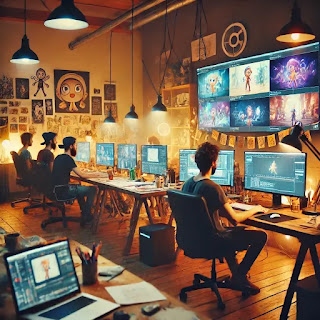In the competitive world of gaming, indie game studios often face the challenge
of creating visually stunning animations without the extensive resources available
to larger companies. However, with innovation and strategic planning, many indie
game studios are making significant strides in producing high-quality animations
that rival those of major game studios. This article explores the techniques and
tools that help indie game studios create stunning animations on a budget,
focusing on game animation studios and game studios in the UK.
Embracing Efficient Animation Techniques
Indie game studios often rely on efficient animation techniques to maximize their
limited resources. Key methods include:
2D Animation Over 3D: While 3D animation can be visually impressive, it is
also resource-intensive. Many indie game studios opt for 2D animation, which
can be equally captivating and more cost-effective. By using vector graphics
and frame-by-frame animation, studios can produce high-quality visuals without
the need for expensive 3D modeling software and hardware.
Cutout Animation: This technique involves animating characters by moving
pre-drawn parts, similar to a digital puppet show. It's less resource-heavy than
traditional frame-by-frame animation and can produce smooth, appealing
animations with the right software.
Sprite Animation: For games with a retro aesthetic, sprite animation is an
excellent choice. By creating and manipulating small, pixel-based images,
indie game studios can create engaging animations that resonate with fans
of classic games.
Leveraging Open-Source and Affordable Software
One of the most significant advantages for indie game studios UK today is
the availability of open-source and affordable animation software. Some
popular options include:
Blender: Although primarily known for 3D modeling, Blender is a powerful tool
for animation. It's free and open-source, making it accessible to indie game
studios. With Blender, studios can create both 2D and 3D animations, giving
them flexibility in their projects.
Spine: This 2D animation software is widely used by indie game studios for its
ability to create smooth skeletal animations. Spine is cost-effective and offers
a range of features that help animators create detailed and fluid character movements.
Krita: Krita is a free, open-source painting program that also supports animation.
Indie game studios can use Krita for frame-by-frame animations and create
stunning artwork without breaking the bank.
Utilizing Procedural Animation
Procedural animation is a technique where animations are generated in real-time
based on algorithms rather than being pre-rendered. This method can save time
and resources for indie game studios. By using procedural animation, studios can
create dynamic and interactive animations that respond to player input,
enhancing the gaming experience.
Outsourcing and Collaboration
Another cost-effective strategy for indie game studios is to outsource specific
animation tasks. By collaborating with freelance animators or smaller game
animation studios, indie developers can access specialized skills and resources
without the overhead costs of hiring full-time staff. This approach is particularly
beneficial for game studios in the UK, where the talent pool is diverse and accessible.
Community and Crowdfunding Support
Indie game studios often rely on community and crowdfunding support to fund
their projects. Platforms like Kickstarter and Patreon allow developers to raise
funds directly from their audience, which can be allocated towards improving
animation quality. Engaging with the community not only provides financial
support but also valuable feedback and a loyal fan base.
Case Study: Success Stories from Indie Game Studios
Several indie game studios have successfully created stunning animations
on a budget, setting examples for others to follow:
Cuphead: Developed by Studio MDHR, Cuphead is renowned for its hand-
drawn, 1930s cartoon-style animation. The developers used traditional
animation techniques combined with digital tools to create a visually striking
game on a relatively modest budget.
Hollow Knight: Team Cherry, the developers behind Hollow Knight, utilized
efficient animation techniques and a small, dedicated team to produce the
game's beautiful, atmospheric visuals. Their focus on detailed 2D animation and
effective use of resources has made Hollow Knight a standout title in the indie
game scene.
Conclusion
Creating stunning animations on a budget is a challenging yet achievable goal
for indie game studios. By embracing efficient techniques, leveraging affordable
software, utilizing procedural animation, outsourcing tasks, and engaging with
the community, these studios can produce high-quality animations that captivate
players. Game animation studios and game studios in the UK continue to innovate
and inspire, proving that limited resources do not have to limit creativity or quality.

.jpg)

.jpg)
No comments:
Post a Comment